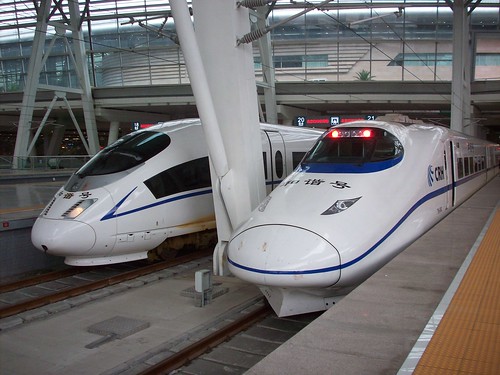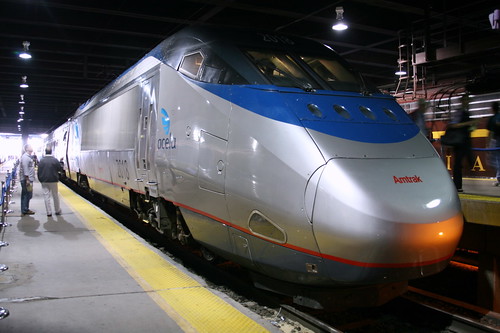Rail Creep – Europe’s High-Speed Rail Revolution Poised to Cross the Atlantic
This article makes an awesome case for high-speed rail.. I like this part:”For decades, the United States ignored technological advances in rail travel, leaving passenger trains in a nostalgic time warp. Devoted to their cars and jetliners, Americans dismissed “bullet trains” as engineering novelties or costly foreign experiments unsuited to the way we live and travel.
But now, 46 years after Japan inaugurated its 130-m.p.h. Shinkansen train service, 29 years after France opened its 160-m.p.h. TGV (Train à Grande Vitesse, or high-speed train), 18 years after Spain launched its high-speed AVE service between Madrid and Seville, the United States finally seems ready to move.”
At precisely 10:30 a.m., with quiet jazz wafting from its speakers, AVE Train 3103 glides out of Atocha Station in central Madrid, its sleek nose pointed east toward a rising sun and Barcelona.
Even with a stop in Zaragoza, the 385-mile trip, which takes seven hours by car, is scheduled to last two hours, 52 minutes. Without the stop, it’s two hours, 38 minutes. Cruising speed: 186 m.p.h.
Of course, the train will be on time: If it’s more than five minutes late, the passengers get their money back.
Compare that with the Pennsylvanian, the daily Amtrak train that travels a similar distance – 353 miles – from Philadelphia to Pittsburgh. That laborious journey takes almost three times as long: seven hours, 23 minutes, a half-hour longer than it took in 1941. Twelve station stops. No jazz. No refunds.
Or compare it to Amtrak’s Acela Express between Philadelphia and Boston: When it’s on time, the train makes that 318-mile trip in about five hours. Slightly faster than driving, but slower and more expensive than flying. And it’s late 30 percent of the time.
In Europe, fast trains are transforming the continent, bringing cities and countries within a few hours of one another, erasing centuries-old regional divisions, resuscitating long-dormant towns, cutting air pollution, creating new economies and manufacturing jobs, and, in a reversal of 20th-century fortunes, making some air travel obsolete.
For a country mired in automotive gridlock and air-traffic jams, increasingly dependent on foreign oil and polluted by its own toxins, the stakes could not be higher.
Here’s the price Americans pay for a transport system that has become overcrowded, wasteful, slow, and expensive: $87.2 billion a year lost in automotive gridlock, more than $750 for every U.S. traveler. That’s more than 2.8 billion gallons of gas wasted – three weeks’ worth per traveler. And time wasted in traffic jams totals 4.2 billion hours – nearly one full workweek for every traveler.
The cost of domestic air-traffic delays, according to a 2008 analysis by the Joint Economic Committee of Congress, is as much as $41 billion annually, including $19 billion in increased operational costs for the airlines and $12 billion worth of lost time for passengers.
The environmental price tag has become starkly clear ever since the Deepwater Horizon drilling rig exploded in the Gulf of Mexico in April, killing 11 people and spilling 210 million gallons of oil. More than 57,000 square miles of the gulf, rich in fish, shrimp, oysters, and crabs, remain closed to fishing because of the disaster.










